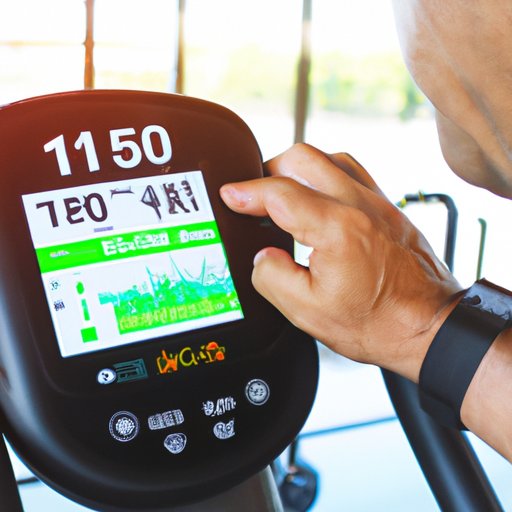
Introduction
Monitoring heart rate during exercise is an important aspect of maintaining a safe and effective workout. By keeping an eye on your heart rate, you can ensure that you’re not pushing yourself too hard or risking injury. In this article, we’ll cover what heart rate is too high during exercise, why monitoring heart rate is important, how you can maintain a safe heart rate during exercise, how to determine your maximum heart rate, the risk of exercising with a high heart rate and how to address it, the benefits of heart rate training, and how to find the sweet spot for optimal results.
Understanding Heart Rate During Exercise
During exercise, your heart rate naturally increases in order to pump oxygenated blood to your muscles at a greater rate. This increase in heart rate is necessary for your body to meet the increased energy demands of exercise.
However, there is a point at which your heart rate becomes too high. The American Heart Association suggests that for most adults, this point is when your heart rate exceeds 85% of your maximum heart rate.
When your heart rate is too high, you’re at risk of experiencing a range of negative symptoms, such as dizziness, nausea, and shortness of breath. In severe cases, exercising with a heart rate that is too high can even lead to heart attack or stroke.
Why Monitoring Heart Rate is Important
By monitoring your heart rate during exercise, you can avoid pushing yourself too hard and risking injury. Additionally, keeping an eye on your heart rate can help you to improve your performance by allowing you to adjust your workout intensity as needed.
Monitoring heart rate can also be a useful tool for injury prevention. If you’re recovering from an injury or have a pre-existing health condition, it’s especially important to maintain a safe heart rate during exercise in order to avoid exacerbating your condition or injuring yourself further.

A Guide to Maintaining a Safe Heart Rate During Workouts
There are several ways to monitor your heart rate during exercise. One of the most common methods is to use a heart rate monitor, which can be worn on your wrist or chest.
To maintain a safe heart rate during exercise, you should aim to stay within a certain target heart rate range. This range will vary depending on your age, fitness level, and the type of workout you’re doing.
For example, if you’re doing moderate-intensity exercise, such as brisk walking or cycling on a flat surface, you should aim to keep your heart rate within 50-70% of your maximum heart rate. If you’re doing high-intensity exercise, such as sprinting or interval training, you should aim to keep your heart rate within 70-85% of your maximum heart rate.
Determining Your Maximum Heart Rate During Exercise
Your maximum heart rate is the highest heart rate you can achieve during exercise. Knowing your maximum heart rate is important because it allows you to determine your target heart rate range and adjust your workout intensity accordingly.
There are several ways to accurately determine your maximum heart rate. One method is to use the age-based formula, which involves subtracting your age from 220. For example, if you’re 40 years old, your maximum heart rate would be 180 bpm (beats per minute).
It’s important to keep in mind that individual differences can impact maximum heart rate. Some people naturally have a higher maximum heart rate than others, and certain factors such as medication use or health conditions can also impact maximum heart rate.
The Risk of Exercising with a High Heart Rate and How to Address It
Exercising with a heart rate that is too high can put you at risk of experiencing negative symptoms such as dizziness, nausea, and shortness of breath. In severe cases, it can even lead to heart attack or stroke.
If you notice that your heart rate is too high during exercise, the first step is to reduce your intensity. This could mean slowing down or taking a break altogether.
It’s also important to pay attention to other symptoms, such as chest pain or discomfort, which could be a sign of a more serious problem. If you experience chest pain or discomfort during exercise, seek medical attention right away.
The Benefits of Heart Rate Training and How to Use it to Improve Your Performance
Heart rate training involves using your heart rate as a guide for determining workout intensity. By doing so, you can ensure that you’re working out at a level that is safe and effective for you.
Heart rate training can be especially useful for endurance athletes, as it allows them to train at a level that is sustainable over a long period of time. Additionally, heart rate training can improve cardiovascular health by increasing your body’s ability to efficiently use oxygen during exercise.
Knowing When to Back Off and When to Push Through
Listening to your body is crucial during exercise. While it’s important to push yourself to a certain extent in order to see results, it’s equally important to recognize when you need to back off and give your body a break.
If you’re experiencing pain, discomfort, or other negative symptoms, it’s important to reduce your intensity or stop exercising altogether. On the other hand, if you’re feeling good and energized, it’s okay to push yourself a little harder.
The Relationship Between Your Heart Rate and Intensity: Finding the Sweet Spot for Optimal Results
The relationship between heart rate and exercise intensity is complex, and there is no one-size-fits-all approach to finding the optimal heart rate for different types of workouts.
However, as a general rule, maintaining a heart rate that is within your target heart rate range is the key to achieving optimal results. If you’re looking to increase endurance or improve cardiovascular health, lower-intensity workouts that keep your heart rate in the 50-70% range are ideal. If you’re looking to improve speed or strength, higher-intensity workouts that keep your heart rate in the 70-85% range are more appropriate.
Conclusion
Monitoring your heart rate during exercise is crucial for maintaining a safe and effective workout. By understanding what heart rate is too high, why monitoring heart rate is important, and how to determine your target heart rate range, you can achieve optimal results and avoid injury. Whether you’re a seasoned athlete or just starting out, taking the time to monitor your heart rate can help you to achieve your fitness goals and stay healthy.
Key Takeaways
- Monitor your heart rate during exercise to avoid injury and improve your performance.
- Aim to keep your heart rate within a certain target heart rate range based on your age, fitness level, and the type of workout you’re doing.
- Your maximum heart rate is the highest heart rate you can achieve during exercise; knowing it can help you determine your target heart rate range.
- If you notice that your heart rate is too high during exercise, reduce your intensity and pay attention to other symptoms, such as chest pain or discomfort.
- Heart rate training involves using your heart rate as a guide for determining workout intensity and can improve endurance and cardiovascular health.
- Listen to your body and adjust your intensity as needed during exercise.
- The relationship between heart rate and exercise intensity is complex, but maintaining a heart rate within your target heart rate range is key for achieving optimal results.




